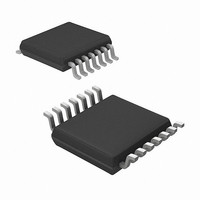MRF49XA-I/ST Microchip Technology, MRF49XA-I/ST Datasheet - Page 61

MRF49XA-I/ST
Manufacturer Part Number
MRF49XA-I/ST
Description
IC RF TXRX 433/868/915 16-TSSOP
Manufacturer
Microchip Technology
Datasheet
1.MRF49XA-IST.pdf
(102 pages)
Specifications of MRF49XA-I/ST
Package / Case
16-TSSOP
Frequency
433MHz, 868MHz, 915MHz
Data Rate - Maximum
256kbps
Modulation Or Protocol
FHSS, FSK
Applications
Home / Industrial Automation, Remote Access, Security Alarms
Power - Output
7dbm
Sensitivity
-110dBm
Voltage - Supply
2.2 V ~ 3.8 V
Current - Receiving
11mA
Current - Transmitting
15mA
Data Interface
PCB, Surface Mount
Antenna Connector
PCB, Surface Mount
Operating Temperature
-40°C ~ 85°C
Number Of Receivers
1
Number Of Transmitters
2
Wireless Frequency
433 MHz to 915 MHz
Output Power
+ 7 dBm
Operating Supply Voltage
2.5 V, 3.3 V
Maximum Operating Temperature
+ 85 C
Mounting Style
SMD/SMT
Minimum Operating Temperature
- 40 C
Modulation
FHSS, FSK
Lead Free Status / RoHS Status
Lead free / RoHS Compliant
Memory Size
-
Lead Free Status / Rohs Status
Lead free / RoHS Compliant
Other names
579-MRF49XA-1/ST
Available stocks
Company
Part Number
Manufacturer
Quantity
Price
Company:
Part Number:
MRF49XA-I/ST
Manufacturer:
IR
Quantity:
450
Part Number:
MRF49XA-I/ST
Manufacturer:
MICROCHIP/微芯
Quantity:
20 000
3.14
The
enables/disables the following functions:
• Receiver
• Transmitter
• Baseband Circuit
• Synthesizer
• Crystal Oscillator
• Low Battery Detect Circuit
• Wake-up Timer
• Clock Output
Figure 3-12 shows the functions that are enabled using
PMCREG.
Receiver: The RXCEN bit, when set, enables the
entire receiver chain. The receiver chain consists of a
baseband circuit, synthesizer and crystal oscillator.
Transmitter: The TXCEN bit, when set, enables the
entire transmit chain. The transmit chain consists of a
power amplifier, synthesizer, oscillator and transmit
register. When the transmit chain and Transmit register
are enabled, any data in the Transmit register is shifted
out and a transmission is started.
Baseband Circuit: The BBCEN bit, when set, enables
the baseband circuit. The baseband circuit, synthesizer
and oscillator work together to demodulate and recover
the data transmitted to the synthesizer (SYNEN bit). If
baseband circuits are enabled, then the oscillator
(OSCEN bit) must be enabled in order to receive data.
The BBCEN bit can be disabled to reduce current
consumption.
Synthesizer: The SYNEN bit, when set, enables the
synthesizer. The synthesizer is comprised of a PLL,
oscillator and VCO for controlling the channel frequency.
This bit must be enabled when either the transmitter or
the receiver is enabled. The oscillator must also be
enabled to provide the reference frequency for the PLL.
On power-up, the synthesizer automatically performs
the calibration. If there are significant changes in voltage
or temperature, recalibration can be performed by
disabling and re-enabling the synthesizer.
Crystal Oscillator: The OSCEN bit, when set, enables
the oscillator circuit. The oscillator provides the refer-
ence signal to the synthesizer when setting the transmit
or receive frequency of use.
Low Battery Detect Circuit: The LBDEN bit, when
set, enables the battery voltage detect circuit. The bat-
tery detector can be programmed to 32 different thresh-
old
programming details.
Wake-up Timer: The WUTEN bit, when set, enables
the wake-up timer. See Register 2-14 (WTSREG) for
details on programming the wake-up timer interval.
© 2009 Microchip Technology Inc.
levels.
Power
Power Management
See
Management
Register 2-16
Configuration
(BCSREG)
register
Preliminary
for
Clock Output: The CLKOEN bit, when set, disables
the oscillator clock output. On device Reset or
power-up, the clock output is enabled so that a proces-
sor can begin execution of any special setup
sequences as required by the designer. See
Register 2-16 (BCSREG) for programming details.
The RF front end is comprised of the Low Noise
Amplifier (LNA) and the mixer. The synthesizer block
has two main components: the VCO and the PLL. The
baseband section consists of a baseband amplifier,
low-pass filter, limiter and I/Q demodulator.
The synthesizer also has an internal start-up calibration
procedure. If quick RX/TX switching is needed, leave
this block on. Enabling the transmitter using the
TXCEN bit (PMCREG<5>) will turn on the PA, and
since the synthesizer is already up and running, the PA
immediately produces the TX signal at the output.
To decrease the TX/RX turnaround time, keep the
baseband section on. Switching to Receive mode
means disabling the power amplifier and enabling the
RF front end. Since the baseband block is already on,
the internal start-up calibration is skipped, and thus, the
turnaround time is shorter. The BBCEN, SYNEN and
OSCEN bits are provided to optimize the TX to RX or
RX to TX turnaround time.
The crystal oscillator provides a reference signal to the
RF synthesizer, baseband circuit and digital signal pro-
cessor. If the receiver or the transmitter is frequently
used, it is recommended to leave the oscillator running
as the crystal might need a few milliseconds to start. The
start timing mainly depends on the crystal parameters.
Note:
Note:
If bit 0 is cleared, and with the clock output
enabled, the oscillator continues to run
even if the OSCEN bit is cleared. The
device will not fully enter Sleep mode.
Leaving blocks unnecessarily turned on
increases the current consumption, and
thus, decreases the battery life.
MRF49XA
DS70590B-page 59












